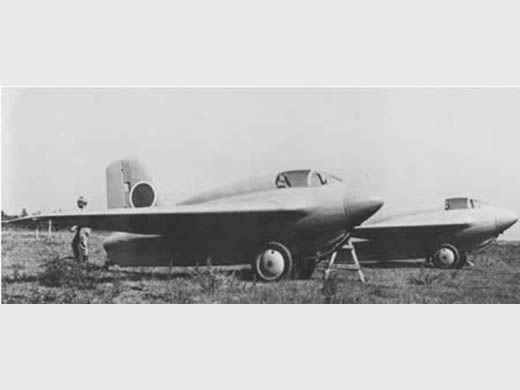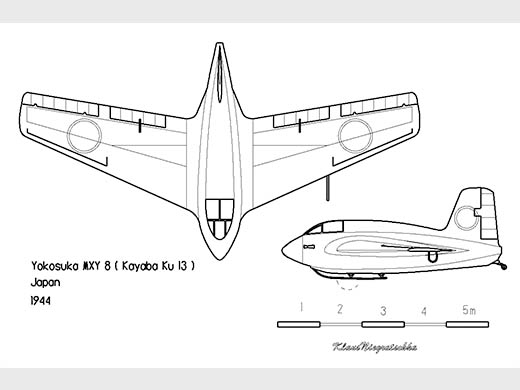
Yokosuka MXY-8 Akigusa
Autre nom (ou nom en langue originelle) : Kayaba Ku-13 / Yokoi Ku-13 Shusui| DONNÉES GÉNÉRALES |
| Année du premier vol (ou de design, si seul projet) |
1945 |
| Pays | Japon |
| Designer(s) | Mitsubishi |
| Premier constructeur | Yokosuka Naval Air Technical Arsenal |
| Type d'appareil | Aile volante |
| Fonction | Expérimental |
| SPÉCIFICATIONS TECHNIQUES |
| Envergure | 9.5 m |
| Longueur | 6.05 m |
| Hauteur | 2.7 m |
| Allongement | -- |
| Surface alaire | 17.73 m2 |
| Profil aile | -- |
| Masse à vide | -- |
| Masse maxi | -- |
| Charge alaire | -- |
| Vitesse mini | -- |
| Vitesse maxi | -- |
| Finesse maxi | |
| Taux de chute mini | -- |
| Nb sièges | 1 |
| Structure | Bois |
AUTRES INFORMATIONS
| Constructeur(s) |
| ||||||
| Infos techniques | -- | ||||||
| Histoire résumée | The appearance of American B-29 Super fortresses over Japan in 1944, produced an urgent need for a high performance interceptor. Inspired by the Me 163 Komet, Mitsubishi engineers, using a German Walter HWK 109-509 rocket motor and an instruction manual for the Me 163B, designed the J8M1 Shusui (swinging sword) for the Japanese Navy, and the Army version, designated Ki-200. A glider version, the MXY-8, was also developed to provide data on handling characteristics of the J8M1 and to be used for rocket pilot training. A prototype glider was flown in early 1945, and subsequently placed in production. Similar training gliders were planned for the Army's Ki-200. A special corps of potential rocket pilots began training at Kashiwa Air Base in the spring of 1945, conducting test and training flights in preparation for the day when the rocket-powered fighters would be available. That day never came. The J8M1 first flew on July 7, 1945, but an engine failure shortly after takeoff resulted in a disastrous crash, killing the test pilot. There were no more flights prior to war's end, although J8M 1 production was underway, and a J8M2 and an advanced Ki-200, designated Ki-202, were planned. The Yokosuka MXY9 Shuka (秋花, "Autumn flower")[1] was a projected development of the MXY8 training glider, adding a small thermojet-style jet engine, the Tsu-11. It was intended to provide further training for pilots who were to fly the Mitsubishi J8M and Mitsubishi Ki-200 rocket-powered interceptor aircraft.None were built prior to Japan's surrender and the end of World War II. The Yokosuka MXY8 Akigusa (秋草, "Autumn grass") was a training glider built in parallel with the Mitsubishi J8M rocket-powered interceptor aircraft. The J8M was to have simply been a licence-built Messerschmitt Me 163 Komet, but due to difficulties in obtaining technical materials from Germany, it eventually had to be designed almost from scratch. The MXY8 was designed in parallel with the J8M to validate the design, and then to provide pilot training during the development of the actual interceptor.[2] The Army designation for the type was Ku-13. The MXY8 was built entirely of wood, and fitted with ballast tanks that would be filled with water to simulate the weight and therefore flight characteristics of a fully equipped J8M. Some 50-60 of these gliders were eventually built. A more advanced trainer, the MXY9, equipped with a primitive jet engine was planned, but was never produced. Many sources apply the designation MXY8 to the Yokosuka MXY7 Ohka kamikaze weapon. | ||||||
| Liens personnalités | Pas de personnalité associée. | ||||||
| Compléments docs |
SOURCES DOCUMENTAIRES
| Liens WEB | Site : Century of Flight . Japanese flying wings, par E.T. Wooldridge (note + photo). (2011-01-01 CL) Site : The Aviation History Museum on Line . Japan's Flying Wings by Raul Colon (note + photo). (2011-01-01 CL) Site : Nuricom (Klaus Niegratschka) . Plan 3 vues. (2011-04-13 CL) Site : Members Site de Klaus Niegratschka . Page du Me-163. Note + photo. (2011-04-13 CL) Site : Axis History Forum . Mitsubishi J8M1 Shusui. (2018-04-03 CL) |
| Livres | Pas de livre référencé. |

Team J2mcL © 2003 -
- Pages optimisées pour Mozilla Firefox

